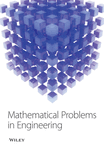SPH Simulation of Acoustic Waves: Effects of Frequency, Sound Pressure, and Particle Spacing
Abstract
Acoustic problems consisting of multiphase systems or with deformable boundaries are difficult to describe using mesh-based methods, while the meshfree, Lagrangian smoothed particle hydrodynamics (SPH) method can handle such complicated problems. In this paper, after solving linearized acoustic equations with the standard SPH theory, the feasibility of the SPH method in simulating sound propagation in the time domain is validated. The effects of sound frequency, maximum sound pressure amplitude, and particle spacing on numerical error and time cost are then subsequently discussed based on the sound propagation simulation. The discussion based on a limited range of frequency and sound pressure demonstrates that the rising of sound frequency increases simulation error, and the increase is nonlinear, whereas the rising sound pressure has limited effects on the error. In addition, decreasing the particle spacing reduces the numerical error, while simultaneously increasing the CPU time. The trend of both changes is close to linear on a logarithmic scale.
1. Introduction
Some classic numerical methods such as the finite element method (FEM) [1, 2], the boundary element method (BEM) [3], and other modified or coupled methods [4–6] are widely used for acoustic simulations. However, these mesh-based methods are not ideal for solving acoustic problems consisting of a variety of media or with deformable boundaries.
Meshfree methods can handle such complicated problems. The method of fundamental solutions (MFS) [7], the multiple-scale reproducing kernel particle method (RKPM) [8], the element-free Galerkin method (EFGM) [9], and other meshfree methods [10, 11] have been applied to these acoustic problems.
The smoothed particle hydrodynamics (SPH) method, as a meshfree, Lagrangian method, was first independently pioneered by Lucy [12] and Gingold and Monaghan [13] to solve astrophysical problems in 1977. In addition, the SPH method has been used in many different fields [14–16]. It not only has most advantages of a meshfree method, but also is suitable for solving problems with material separation or large ranges of density as illustrated in recent reviews by Li and Liu [17], Springel [18], M. B. Liu and G. R. Liu [19], and Monaghan [20] due to its Lagrangian property. Introducing the SPH method to acoustic computation also brings its advantages to some fields like bubble acoustic, combustion noise, sound propagation in multiphase flows, and so on.
With the advance of the SPH method in acoustic simulation, some research literatures [21, 22] discussed solving fluid dynamic equations to simulate sound waves. In addition, we published a conference paper [23] that used the SPH method to solve linearized acoustic equations for modeling sound propagation and interference. Numerical results showed that the SPH method was capable of accurately modeling sound propagation, but the effects of frequency and sound pressure on the SPH simulation need further discussion. Therefore, the present paper focuses on discussing the effect of frequency and sound pressure of the acoustic waves on the numerical error caused by the SPH simulation.
The present paper is organized as follows. In Section 2, the standard SPH theory is used to solve the linearized acoustic equations. In Section 3, a one-dimensional sound propagation model is built. In Section 4, a numerical experiment is given based on standard SPH algorithms, and the effect of frequency, sound pressure, and particle spacing on the simulation is analyzed with considering the changes of particle spacing and Courant number. Section 5 summarizes the results of this work.
2. SPH Formulations of Sound Waves
2.1. Basic Formulations of SPH
2.2. SPH Formulations of Sound Waves
The second-order leap-frog integration [26] is used in the present paper. All-pair search approach [24], as a direct and simple algorithm, is used to realize the neighbor particles searching in the acoustic wave simulation.
3. Sound Propagation Model
In order to evaluate the effect of sound pressure and frequency, a one-dimensional sound wave which propagates in a pipe with uniform cross section is used. The acoustic model is shown in Figure 1. The sound pressure at t = 0 is plotted with a solid line, while the sound pressure at t = 0.1 s is plotted with a dashed line.
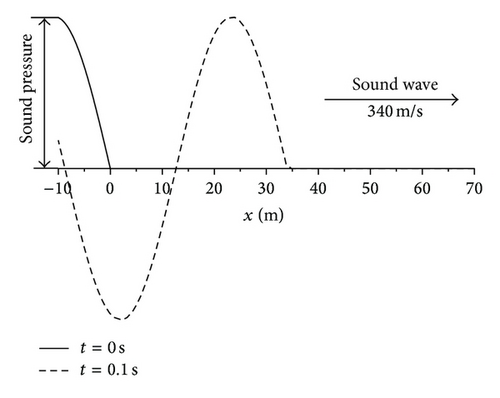
The sound propagates from x < 0 to x ≥ 0, with the SPH computational region going from −10 m to 70 m. In the computation, the region of the sound source is from −10 m to 0 m, which is determined by the theoretical solutions, while the region of sound propagation is from 0 m to 70 m, which is obtained by the SPH method. At the end of the sound propagation domain, the particles are set free in the computation. Since the SPH computational region is far longer than the sound propagation distance, any effects caused by ignoring this boundary will not propagate to the sound propagation domain and therefore can be neglected. The simulation results at the time t = 0.1 s are used to compare with the theoretical solutions. A similar numerical model is used in our recent conference paper [23].
4. Results and Discussion
4.1. Numerical Experiment
A sound propagation model is built to confirm agreement between SPH simulation results and the theoretical solution. The parameters used in the numerical experiment of the sound waves are listed in Table 1. The physical time required for the modeling was 141.6 seconds.
| Model parameters | pAmp | w | c0 | t |
|---|---|---|---|---|
| 50 Pa | 50 rad/s | 340 m/s | 0.1 s | |
| Computational parameters | Particle spacing | Smoothing length | Courant number | Particle mass |
| 0.04 m | 0.13 m | 0.05 | 0.04 kg |
A comparison between the SPH results and theoretical solutions of sound pressure at t = 0.1 s is shown in Figure 2. The theoretical solution is plotted with a solid line while the SPH results are plotted with red points. In order to clearly identify the numerical results, the points are plotted at intervals of 12.
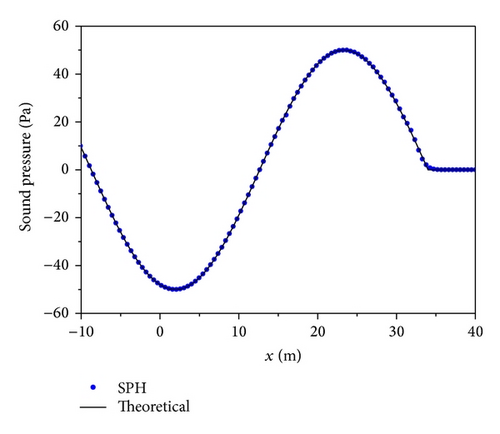
As shown in Figure 2, the sound pressure of the sound wave changes along with the position, and a peak and a valley appear in the final wave at t = 0.1 s. Comparing with the analytical data, it can be seen that the SPH method can accurately simulate the sound pressure of an acoustic wave as the values of sound pressure can be obtained precisely, and the simulation error is 1.6 × 10−4. The trend of both the SPH results and the theoretical solutions also has a similar tendency.
4.2. Effect of Frequency
Different sound propagation models with the circular frequency of sound changing from 10 rad/s to 200 rad/s are simulated, and the effect of circular frequency is discussed. In the discussion, different computational parameters, namely, the particle spacing and the Courant number, are also considered.
Figure 3 gives the numerical error for different computational cases with different w and particle spacing. Figure 4 shows the sound pressure error for different cases with different values of circular frequency and Courant number. Each point in both figures stands for a computational case. The Courant number used in the computational cases in Figure 3 is 0.05, and the particle spacing used in all cases in Figure 4 is 0.06 m.

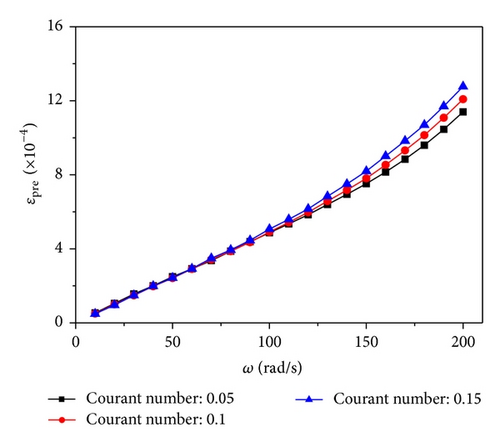
As can be seen from Figure 3, εpre increases along with the increase of w, and the increase of εpre is nonlinear. Along with the increase of w, the increase of εpre is larger. On the other hand, we can see from the line graph that εpre is much larger than other positions when w is 200 rad/s. The numerical error grows faster when the particle spacing is larger.
As shown in Figure 4, εpre increases along with the increase of w. What is more, three lines are represent three different Courant numbers, namely, three different choices of time step when the particle spacing is the same. εpre obtained from three different Courant numbers has almost the same value when w is under 100 rad/s. After that, some difference is shown among three lines when w becomes larger, but the Courant number affects the effect of w less in general.
4.3. Effect of Sound Pressure
In the present section, different sound propagation models with the maximum sound pressure amplitude changing from 10 Pa to 200 Pa are simulated, and the effects of sound pressure are discussed. At the same time, different computational parameters, namely, the particle spacing and the Courant number, are also used in the simulation. The w of the sound in all computational cases in this section is 50 rad/s.
Figure 5 illustrates the changes of sound pressure error when the numerical model uses different pAmp and particle spacing. Figure 6 describes the changes of error with different pAmp and different Courant numbers. Each point in both figures stands for a computational case. The Courant number used in all computational cases in Figure 5 is 0.05, and the particle spacing used in all cases in Figure 6 is 0.06 m.
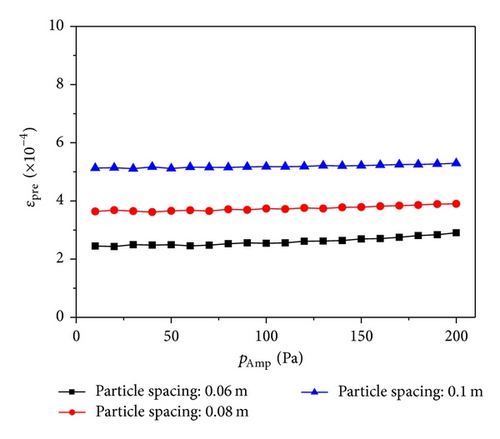
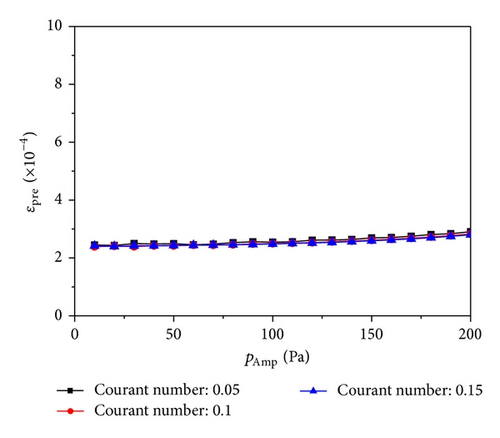
It can be seen from the line graph that εpre has limited change, which is a little increase, along with the increase of pAmp. The trend of the line is approximately linear when pAmp changes from 10 Pa to 200 Pa. The value of three lines in the figure is around 2.7 × 10−4, 3.7 × 10−4, and 5.2 × 10−4 corresponding to the particle spacing changes from 0.06 m to 0.1 m. In other words, when the particle spacing increases, the error shows an upward trend.
Similarly, εpre rises a little along with the increase of the amplitude of sound wave as shown in Figure 6. Specifically, εpre stays at about 2.6 × 10−4 when the amplitude of sound changes from 10 Pa to 200 Pa. Although with different Courant number, the error of numerical results has similar values. The largest difference of εpre among three lines is 2.0 × 10−5, which happens when pAmp reaches 200 Pa.
4.4. Effect of Particle Spacing
In addition to the accuracy, the convergence and the computational efficiency are also worth concern. Particle spacing, as an important parameter in the SPH simulation, affects these indexes a lot. In this section, the effects of the particle spacing are analyzed based on the model in Section 4.1 with the particle spacing (Δx) changes from 0.03 m to 0.3 m.
Different sound pressure errors corresponding to the SPH simulation results with different Δx are shown in Figure 7. Three different types of points are used in the figure to represent Courant numbers of 0.05, 0.10, and 0.15 in the computation. In order to clearly show the trend, logarithmic scales are used for both axes in the figure.
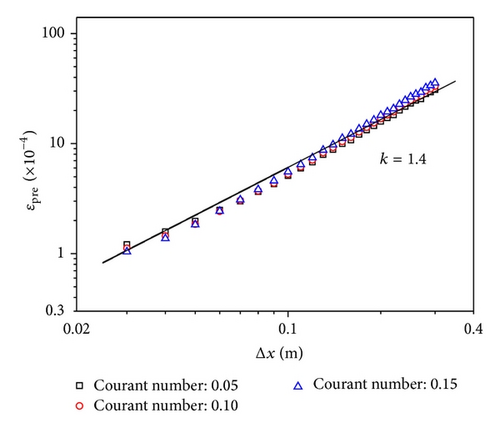
As can be seen from Figure 7, there is an approximately linear relation between εpre and Δx with double logarithmic coordinates. As Δx increases, εpre also increases. This result indicates a convergence of the simulation, as a smaller Δx leads to a more accurate result. Note that the errors generated with the three different Courant numbers all have similar values. A linear fitted curve obtained by using all εpre results produces a slope of approximately 1.4 for the fitted line.
The required CPU cost in terms of time to perform the SPH simulation corresponding to different Δx values is given in Figure 8. Three different point types were also used to represent different Courant numbers in the computation. The figure also shows the linear fit lines for each Courant number, as well as the calculated slopes.
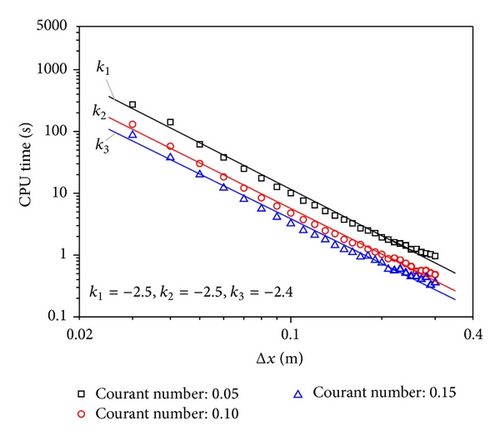
The graph shows that the CPU time logarithmically decreases from hundreds of seconds to about one second as Δx increases from 0.03 m to 0.3 m. This decreasing trend is roughly linear, with an absolute slope value of approximately 2.5. Although the CPU time is different for each Courant number, the trends are similar. Thus, an appropriate particle spacing value can be decided within a certain range by comparing the results in Figures 7 and 8 for a given application.
5. Conclusions
- (1)
The results of computational cases, with the acoustic wave frequency changes from 10 rad/s to 200 rad/s, show that the rising of sound frequency increases simulation error, and the increase is nonlinear.
- (2)
As the maximum sound pressure amplitude changes from 10 Pa to 200 Pa, the rising sound pressure increases the simulation error. However, the resulting change in error is limited and marginal.
- (3)
Decreasing the particle spacing in the computation reduces the numerical error, while simultaneously increasing the CPU time. The trend of both changes is close to linear on a logarithmic scale. The Courant number has little effect on the error generated with different sound frequency or sound pressure, whereas the particle spacing has a more significant influence on both properties.
Conflict of Interests
The authors declare that there is no conflict of interests regarding the publication of this paper.
Acknowledgments
This study was supported by the Independent Innovation Foundation for National Defence of Huazhong University of Science and Technology (no. 01-18-140019). Y. O. Zhang is supported by the China Scholarship Council (201406160032).



